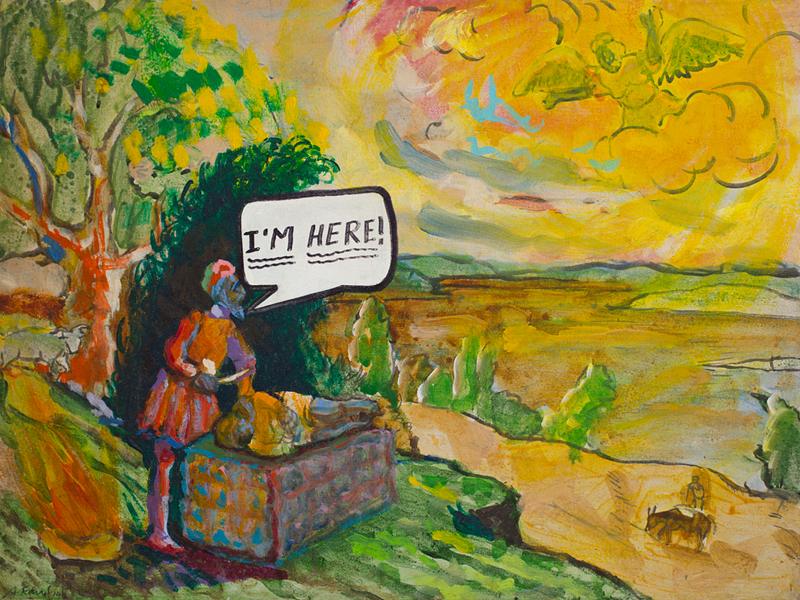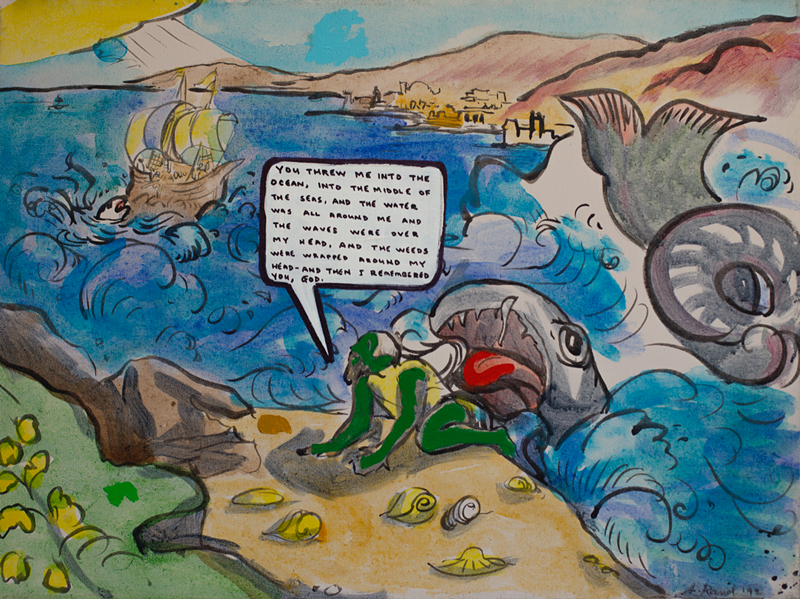Rendered in expressionistic comic-book style, Adam and Eve — yes, that Adam and Eve — stand aghast by the tree of life as a snake coils around it. Animals blur in the background and a thickly-outlined speech bubble protrudes from the man’s mouth: “WE’RE NAKED.” Double underline.
That’s how the Skirball Museum’s current exhibition, Archie Rand: Sixty Paintings from the Bible, begins. Rand’s work moves through the Hebrew Bible in chronological order but brings a modern directness to the stories within. The panels are often subversive and profane, yet unabashed in their religiousness.
Another painting depicts a woman of Egyptian descent — Potiphar’s wife, Zuleikha — attempting to seduce Joseph. The biblical text dodges the more lewd aspects of the story. Rand’s take, however, cuts to the center. Laid out on her bed, she reaches a hand toward Joseph. In all capital lettering, she exclaims: “FUCK ME!”
Rand told me that, after 25 years of being obedient, this series is the one where he decided “to throw it out the window.”
Rand, a presidential professor of art at Brooklyn College, Guggenheim fellow and recipient of the National Foundation for Jewish Culture’s Achievement Medal, has had over 100 solo exhibitions and been included in upwards of 200 group shows.
For this series, he drew inspiration from the work of the 17th-century Swiss-born engraver Matthäus Merian, whose work Rand came upon via a publication that had reproduced hundreds of the artist’s prints, which depicted scenes from the Bible. He had originally stayed faithful to Merian’s classical style. But he decided it would lessen their impact to do so.
“I decided to sabotage the drawing, which is very Jewish,” Rand laughed.
The Skirball exhibition came here somewhat serendipitously through curator Samantha Baskind, a scholar who visited Skirball months prior to study their Moses Jacob Ezekiel collections. Abby Schwartz, the museum’s director, recalls Baskind seeing the space and saying, “Literally, do I have a show for you.” (Sixty Paintings From the Bible marks the reopening of Skirball’s temporary exhibition space, which was closed since September due to renovation of lighting and displays.)
Baskind recalls her fascination with Rand’s prolific career and the varying styles in which he paints, and so she traveled to New York to visit him. Having mentioned a particular interest in the series, she recalls him pulling all 60 paintings out and spreading them all over his home, laid out on his couch and floor.
“I just felt like there was something that had to be said in more depth than what had been said. So many people just pull out one or two canvases, but what they say as a whole pretty much intrigued me,” Baskind said. “And then I saw this series, and we've talked about it a lot, as somewhat of a turning point in his art, and wanted to highlight that. And then finally, they hadn't been shown together since they were really first made. And I wanted to bring them back together.”
Rand said they were first exhibited as part of a secular show the same year they were completed — 1992. The curator had viewed them as a sarcastic commentary on religion, a take Rand didn’t agree with, but he was just happy to have them shown. Unlike the current exhibition’s spread-out chronology, they hung together on one large wall. (Under Baskind, the show was first exhibited in 2016 in Cleveland and then in Pittsburgh the following year.)
“Samantha was the first person to resuscitate them from the dead. And I’m glad because I love them,” Rand laughed, adding that the “spectacular” lighting in the Skirball show makes the colors pronounced.
Scanning the paintings, Baskind noted that it’s important to point out how Rand “uses different linguistic techniques on various canvases.” Like the panels within a comic book, Rand wields various methods to convey the mood of each scene. Speech bubbles may be rounded or square. Some are without a pointer. Words scream in uppercase or are made small, as if whispering.
The choice of pulling from comic-book imagery is, in itself, a nod to the industry’s deep Jewish roots. Rand said that Jewish artists who had training during the Great Depression “entered and basically invented this underground, filthy, anti-elite system of making art, which was the comic book industry.” He references Will Eisner, an early pioneer of the medium, Mad Magazine and Stan Lee. Superman, Spiderman, Captain America, Batman, the Fantastic Four and X-Men were all created by Jewish artists.
“Comic books were the visual language that I could invade to make a Jewish statement,” Rand said, adding that, because it’s the Bible, there’s nothing necessarily inherently Jewish about the work, but he kept it within the Apocrypha, or old testament. In his statement, Rand notes that Sixty Paintings is meant to be “a rush of images — a whirlwind that confronts the viewer.”
In using common vernacular, the body of work, as Schwartz points out, places these biblical stories into the contemporary context of “movements like #metoo and gender issues and so many of the issues that plague our society today.”
Several events are tied to the exhibition, including a talk with Baskind as part of a "lunch and learn" session on April 2 from noon-1:30. For more info, visit huc.edu.
*A previous iteration of this article stated that Baskind would speak at the Skirball Museum on March 10. Due to concerns regarding the coronavirus, the event was postponed and rescheduled to April 2.








